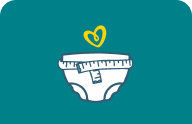Corrected Gestational Age
Welcoming a premature baby into the world comes with unique challenges and many special moments. One key aspect that parents and caregivers need to understand is the concept of corrected gestational age. This adjusted age is crucial for accurately tracking your preemie’s development and milestones. In this article, we’ll explore what corrected gestational age is, why it’s important, and how to calculate adjusted age for your little one. Whether you’re a new parent or a healthcare provider, understanding this concept will help ensure that preterm infants receive the care and support they need to thrive.
What Is Corrected Gestational Age?
As well as wondering what corrected age is, you may have also heard the term “adjusted age.” So what is “corrected” or “adjusted” age for a baby? Corrected gestational age or adjusting for prematurity simply means using a corrected age for your preterm baby.
The age of a baby can be calculated in two ways. The first way is called the uncorrected age, which is the number of weeks or months that have passed since your baby was born. The second way is called the corrected age, which takes into account the time that has passed since your baby's original due date.
This can help you and your child’s caregivers better understand where your premature baby is in their growth journey. Plus, it’s helpful as you learn how to care for your preemie baby at home.
What Is Chronological Age?
Your baby’s chronological age is based on how long it has been since they were born. So with a baby born at-term, this is simply their age.
When to Use Adjusted Age?
Using your baby’s adjusted/corrected age for prematurity is important for healthcare professionals when assessing their development. For instance, a baby born 2 months early who is now 6 months old would have a corrected age of 4 months. Despite having spent 6 months in the world, this baby wouldn’t be expected to meet the typical developmental milestones of a 6-month-old. Instead, healthcare providers would monitor their growth and progress as they would for a 4-month-old.
Baby Development Milestones Watching how your baby grows and develops is an important part of parenthood. Keep track of your little one's progress with our articles! Learn more
How to Calculate Adjusted Age
Learning how to calculate corrected gestational age for premature babies helps you better understand your baby’s growth and development milestones. Here’s a simple way to calculate it:
Start with the birth date: Start with the number of weeks since your baby’s birth.
Calculate the number of weeks early: Determine how many weeks early your baby was born. For example, if your baby was born at 30 weeks, they were 10 weeks early (since full-term is 40 weeks).
Subtract from current age: Take your baby’s actual age in weeks and subtract the number of weeks they were early.
For instance, if your baby is now 12 weeks old and they were 10 weeks early, their corrected gestational age would be 2 weeks
Why Is Adjusted Age Important?
Gestational age helps track your baby’s progress based on their due date rather than their actual birth date. The chronological age of a premature baby may not accurately reflect their growth and development. For instance, if a baby is born at 40 weeks, they may start cooing or smiling at 1 month, while a 30-week preemie might still be in the NICU, working on catching up with the growth and development that they missed out on in the uterus.
It is crucial to use a corrected age for premature babies to track milestones. This adjusted birth date is essential for monitoring growth, newborn development, and explaining delayed milestones.
How Long Should You Use Corrected or Adjusted Age?
So, when do you stop adjusting age for prematurity? You should use your baby’s adjusted or corrected age until they are about 2 years old. This period allows for a more accurate assessment of your baby’s growth and development milestones, as preemies often catch up with their full-term peers during this time.
Always consult with your child’s healthcare provider to determine the best approach for your little one, as each preemie’s journey is unique.
Corrected Age: Growth and Development
Every baby, including preemies, develops at their own rate. However, when considering your preemie’s development and growth, it’s important to use their adjusted age because they generally reach developmental milestones later than a full-term baby. These development milestones may include:
Waving arms and legs
Turning their head when enjoying tummy time
Holding their head up
Standing and supporting their own weight
Taking steps with help
Picking up and putting down objects with one hand
Standing and taking steps independently.
Essentially, but not precisely, corrected gestational age begins at your baby’s original due date, which is typically around 37 to 40 weeks. Therefore, they will still achieve these important milestones, but at their adjusted age.
Corrected Age: Play and Social Interaction
As with growth and development, preterm babies may reach language and social development later than at-term babies, so using their corrected age is important. These social and language skills include:
Communication through Crying
Laughing and squealing
Repeating sounds you make
Saying first words
Looking at an object when you refer to it and communicating by pointing
Smiling when spoken to or when they see you
Smiling and cooing at themselves in a mirror
Recognizing familiar faces
Following simple commands, like “come here” or “put it down”
Showing affection to a doll or toy
Playing by rolling or tossing a toy back and forth with others.
As we mentioned above, there’s no need to be concerned—your little one will likely reach these milestones at their corrected age.
The Bottom Line
Understanding and utilizing corrected gestational age is essential for accurately assessing and managing the development and health of preterm infants. This adjusted age calculation helps healthcare providers and parents better interpret growth, developmental milestones, and appropriate medical care.
Check out our article dedicated to premature baby development for more helpful information. And while you’re here, why not download our Pampers Club app to receive rewards on all those diaper purchases.
How We Wrote This Article The information in this article is based on expert advice found in trusted medical and government sources, such as the American Academy of Pediatrics and the American College of Obstetricians and Gynecologists. You can find a full list of sources used for this article below. The content on this page should not replace professional medical advice. Always consult medical professionals for full diagnosis and treatment.









